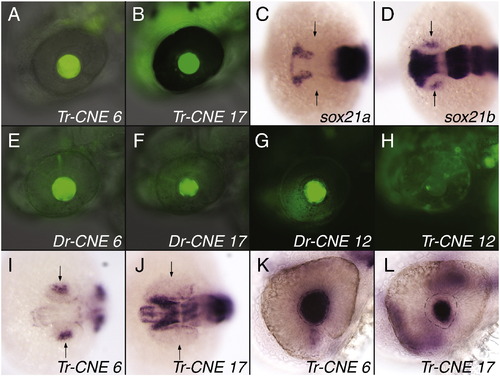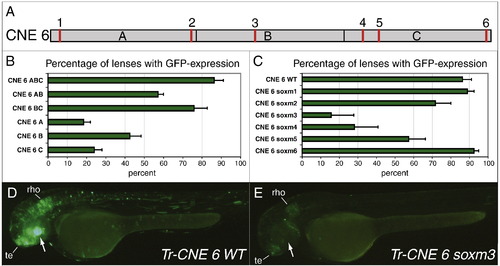- Title
-
Lens development depends on a pair of highly conserved Sox21 regulatory elements
- Authors
- Pauls, S., Smith, S.F., and Elgar, G.
- Source
- Full text @ Dev. Biol.
|
GFP and Sox21 expression in the zebrafish lens. (A, B) Stable transgenic lines expressing GFP in the lens under the control of Fugu CNE 6 (A) and Fugu CNE 17 (B) at 52 hpf. (C, D) sox21a and sox21b expression in zebrafish at the 20 somite stage. (E–H) Transient GFP-expression in the lens at 52 hpf activated by zebrafish CNE 6 (E), zebrafish CNE 17 (F) and zebrafish CNE 12 (G). In contrast to the zebrafish orthologue Fugu CNE 12 is not active in the lens (H). (I–L) GFP expression in stable transgenic lines. Only CNE 6 is active in the lens at 20 somites (I) whereas CNE 17 activity at this stage is limited to the CNS (J). At 30 hpf also CNE 17 is active in the lens (L) but in a more central domain than CNE 6 which seems to drive expression throughout the lens (K). (A, B, E–H) GFP fluorescence, anterior to the left. (C, D, I–L) Whole-mount in situ hybridizations, anterior to the left. Dorsal view (C, D, I, J), lateral view (K, L). Arrows indicate position of the lens during early stages. A dashed line marks the boundary of the lens in K and L. Tr (Takifugurubripes, Fugu), Dr (Danio rerio, zebrafish). EXPRESSION / LABELING:
|
|
Lens expression from a Fugu Sox21 BAC. (A) Genomic region included in Fugu BAC278I13. The BAC is shown as a black line, exons in red and the region including the Sox21 CNEs in blue. The CNE region is shown by indicating the first upstream CNE and the last downstream CNE. (B) Transient expression of BAC Sox21:GFP in zebrafish at 30 hpf. (C, D) Whole-mount in situ hybridizations for zebrafish sox21a (C) and sox21b (D) at 30 hpf. (B–D) Absence of expression in the dorsal diencephalon is indicated with arrowheads. (E) Transient expression of BAC Sox21:GFP in the zebrafish lens at 52 hpf. (F, G) Intensity of GFP-fluorescence in lenses after the injection of different variants of BAC Sox21:GFP. Error bars indicate standard error of the mean. (F) Mean average intensities of lens expression. (G) Percentage of lenses with maximum levels of intensity. full = BAC Sox21:GFP including all CNEs (n = 51); d6 = deletion of CNE 6 (n = 51); d8 = deletion of CNE 8 (n = 30); d17 = deletion of CNE 17 (n = 43); d6,17 = double deletion CNE 6/CNE 17 (n = 25). (H) Lens expression of different variants of BAC Sox21:GFP. Each row shows 12 representative images of transient GFP expression in the lens at 52 hpf. Note that GFP expression in row ‘d6’ tends to be restricted to the centre of the lens whereas residual GFP-expression in row ‘d17’ is often detected in the entire lens. Moreover, the construct lacking both CNEs (d6, 17) performs consistently worse than the single deletions and fluorescence never exceeds background levels. Abbreviations of BAC constructs as in (F, G). EXPRESSION / LABELING:
|
|
Morpholino knock-down of zebrafish Sox21b. (A) Lens of a control embryo injected with a 5 bp-mismatch morpholino at 3 dpf. (B) Lens of a morpholino-injected embryo at 3 dpf. (C) Percentage of embryos showing the same lens phenotype as in (B) when injected with the morpholino (MOsox21b), the morpholino together with the sox21b mRNA (MO + sox21b mRNA) or with the 5 bp-mismatch morpholino (control). Error bars indicate standard error of the mean. PHENOTYPE:
|
|
Dissection of the Fugu CNE 6 lens enhancer. (A) Schematic drawing of CNE 6 to indicate the subdivision into three parts (ABC) for the deletion analysis and the position of the six putative Sox binding sites (red) numbered 1–6. (B) Percentage of GFP-positive lenses in zebrafish injected with various deletion clones of Fugu CNE 6 (ABC = full-length CNE 6). (C) Percentage of GFP-positive lenses in zebrafish injected with different mutated versions of CNE 6. All 6 putative Sox sites were mutated separately (soxm1-6). (D,E) Transient GFP expression in 52 hpf-old zebrafish injected with the Fugu CNE 6 WT sequence (D) or a variant carrying a mutation in putative Sox site 3 (E). The lens is indicated by an arrow. Note that absence of lens expression in (E) correlates with lower expression levels in telencephalon (te) and rhombencephalon (rho). Tr (Takifugu rubripes, Fugu). |
Reprinted from Developmental Biology, 365(1), Pauls, S., Smith, S.F., and Elgar, G., Lens development depends on a pair of highly conserved Sox21 regulatory elements, 310-318, Copyright (2012) with permission from Elsevier. Full text @ Dev. Biol.




